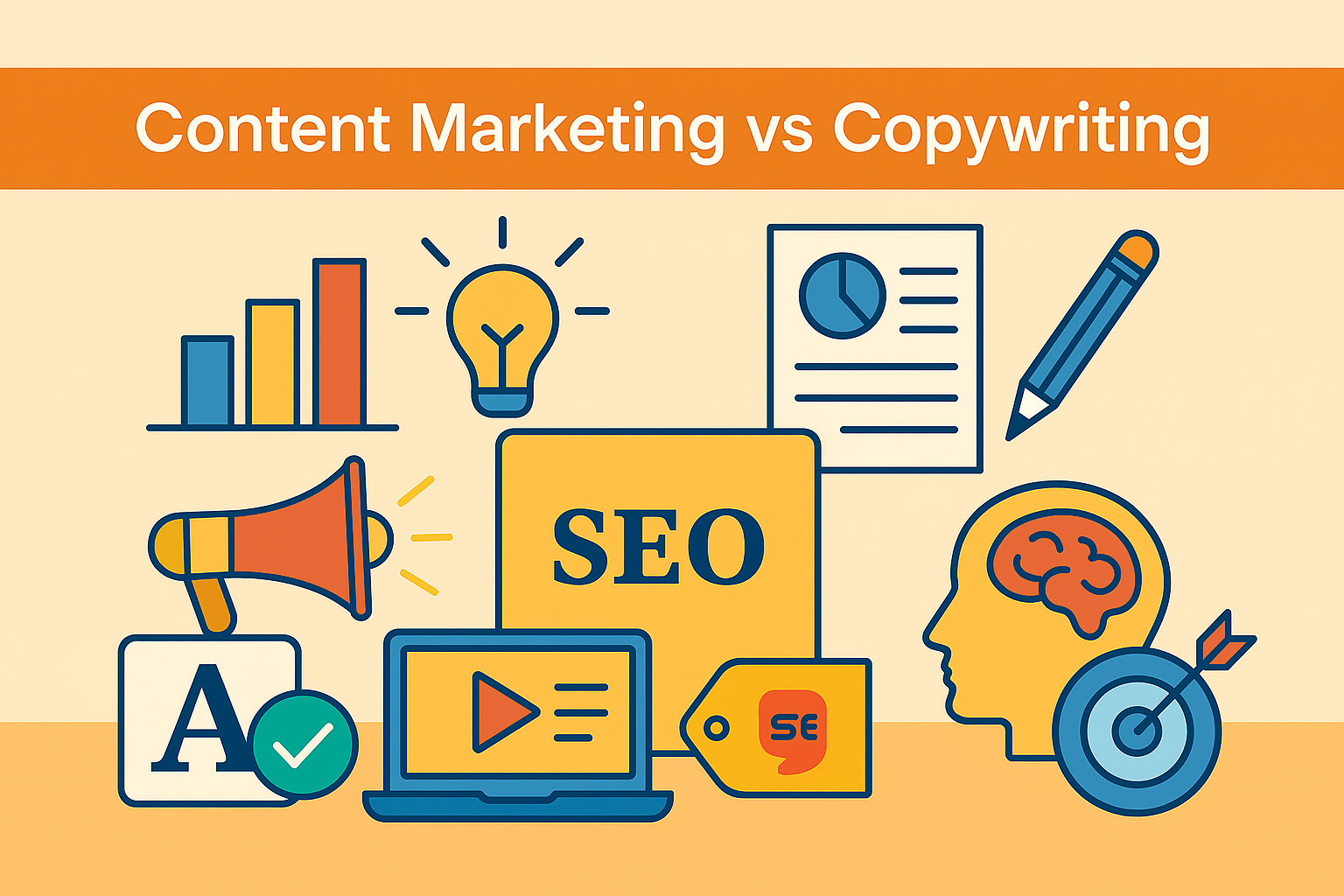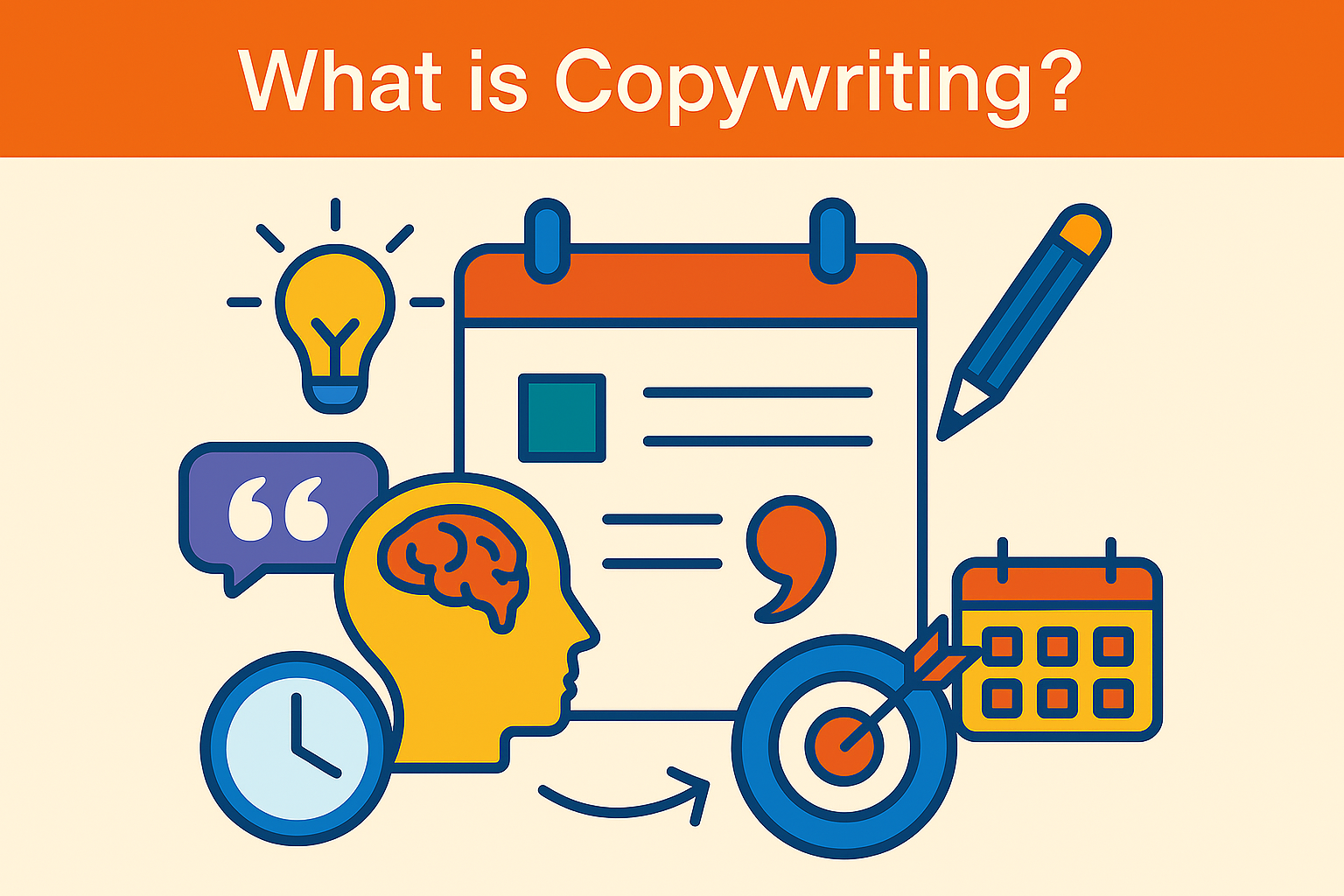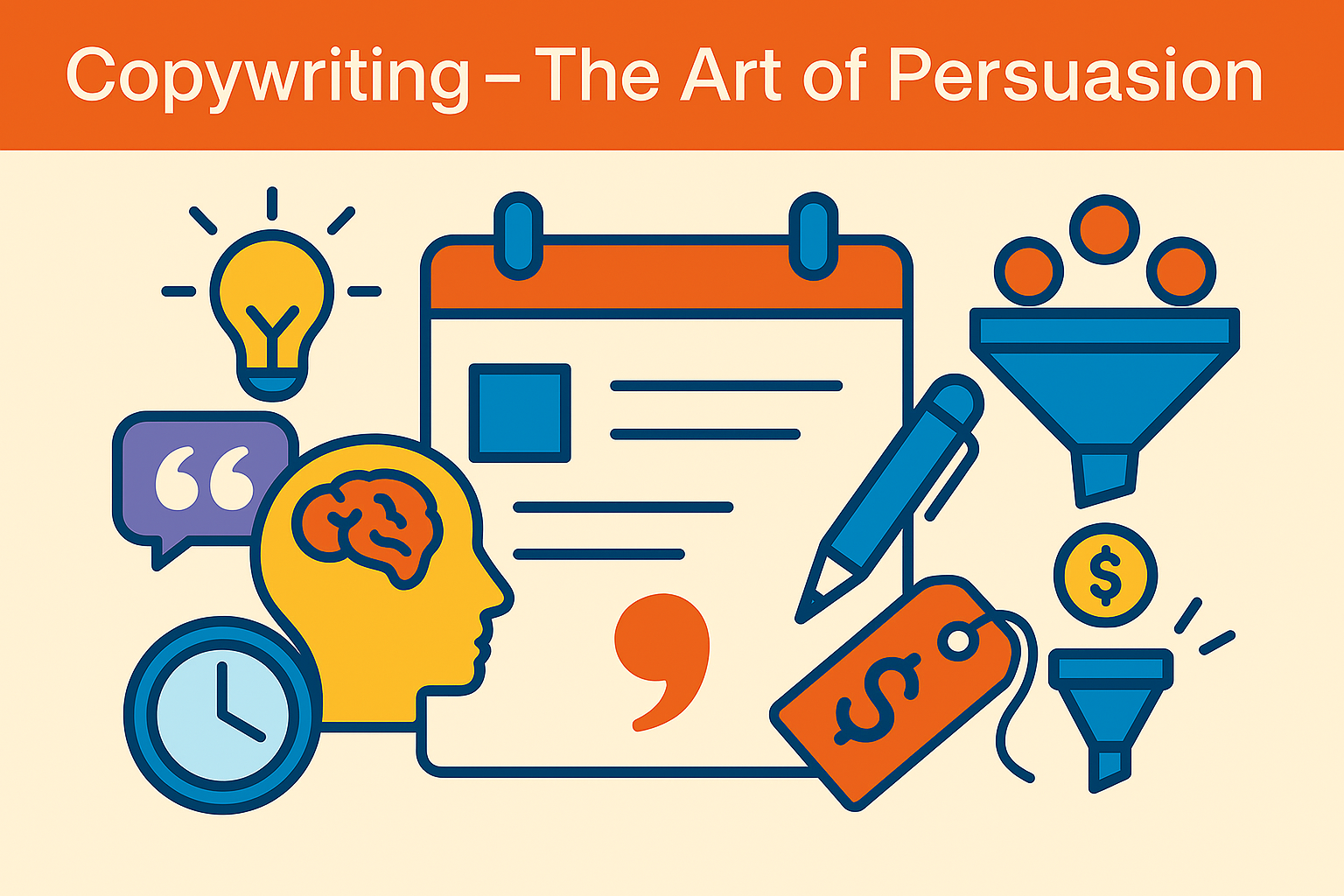This article looks at content marketing and copywriting and the similarities and differences between the two.
We start with a look at content marketing, defining what it is and its various component elements.
Next, we define copywriting, tracing its origins and how it evolved with the web.
We then compare content marketing and copywriting, focusing on areas where they overlap, outlining the key differences and explaining how best to integrate both disciplines.

In This Article You Will Learn:
- What is Content Marketing?
- What is Copywriting?
- Content Marketing & Copywriting similarities
- How Content Marketing & Copywriting differ
- What Copywriters can learn from Content Marketers & vice versa
- How to create an integrated ‘Best of Both Worlds’ strategy
- The importance of a company-wide style guide
Content Marketing & Copywriting – Overview
Although they are two distinct marketing disciplines, people often confuse content marketing and copywriting, lumping them both together.
This is why employers tend to advertise content marketing roles as copywriter positions and vice versa.
A content marketer is, in essence, more of an all-rounder, capable of creating a wide variety of content for web, social and various multimedia platforms.
A copywriter is more of a specialist, someone who writes content designed to convert sales, be that website copy, ad copy or scripts for broadcast advertising.
It shouldn’t be assumed, therefore, that a professional copywriter is also adept at creating TikTok content. Or, for that matter, that a content marketer who specialises in social media will be equally talented at writing the copy for your company website.
In a large organisation, both disciplines tend to exist in separate teams or departments. And those departments don’t always communicate with each other as often as they should.
In smaller organisations content marketing and copywriting are often unified in a single team or, in some cases, a single individual.
Such an individual has a huge advantage in today’s business environment, where having a blend of both skills has become highly valued.
At the very least, a good content marketer should understand copywriting principles and best practices to ensure their content is as engaging and persuasive as possible.
With an ever-evolving marketing landscape, plus the added threat from AI, copywriters should expand their skillsets to include basic competencies in design, graphics, social media and SEO.
As a business owner, meanwhile, having a basic grasp of both content marketing and copywriting principles gives you a distinct advantage in the marketplace.
The more you learn about these disciplines the more you will begin to see them in action as you browse online. You’ll start to understand how successful companies integrate both to drive brand awareness, loyalty and revenue.
What Is Content Marketing?
Content marketing is an all-encompassing marketing strategy to drive awareness, customer engagement, loyalty and conversions across multiple mediums and channels.
The primary goal of content marketing is to create and disseminate content that is timely, relevant and audience-focused.
Blog articles, email newsletters and social media posts comprise the bulk of content marketing initiatives, alongside images/graphics, slideshows, videos, podcasts and other forms of multimedia including ebooks and apps.
Content Marketing Strategy

The first step of any content marketing strategy is to establish your goals and objectives.
These will differ from company to company, industry to industry and, indeed, platform to platform, but will generally include one or all of the following:
- Awareness: Building brand awareness while informing customers about your company and its products/services, new product launches, special offers and sales.
- Engagement: Getting your audience to engage with your business throughout multiple stages of the customer cycle while rewarding customer loyalty.
- Knowledge: Helping your audience understand your products to make better decisions while winning trust. Providing valuable information that helps establish your company as an expert in its field.
- Sales: Leveraging content marketing to drive sales and conversions directly, e.g. through e-commerce, social commerce, in-app transactions, etc.
- Customer Service: Using multiple platforms to speak directly with customers, engaging with them and addressing their issues efficiently.
Plan Your Content Marketing With A Content Calendar

The key to successful content marketing is careful planning and unified messaging, best achieved through the use of a content calendar.
This helps to plan your content marketing strategy months in advance. It allows you to be more effective in your promotions and offers, providing a more consistent audience experience.
It also streamlines content creation as you can more readily recycle text and other assets such as images and videos.
Measure Your Success
Having set your goals and objectives and mapped out your content strategy for the months ahead, the next step is to set up reporting.
For most companies, combining data from web analytics platforms like Google Analytics, with insights from your social media and email newsletter dashboards is sufficient.
The trick is to merge these into a streamlined report that focuses on core objectives and keeps your data clean, making it easy to measure progress over the short and long term.
What Is Copywriting?
Copywriting is a much older discipline that predates content marketing, and the internet itself, by a considerable amount.
The profession can be traced by to the 19th century, as psychology was growing in prominence.
Advertising and marketing were both influenced by the work of Sigmund Freud.
And just as Freud helped to establish the field of psychology worldwide, his nephew in America, Edward Bernays, established the field of public relations and with it, the synergy of psychology and marketing which continues to this day.
What Does A Copywriter Do?
Copywriting is all about persuasion.
Its first golden age came during the post-war consumer boom.
Rather than pesky salesmen jamming their foot in doors desperately trying to earn their commission with product demos, companies soon realised that individual persistence was no match for mass persuasion.

So instead of hiring entire divisions of salesmen, they found it more efficient to engage through mass market media, namely print, radio and television.
Enter the copywriters.
Rather than focusing on what a product does, this new breed of “Mad Men” focused on how a product feels.
And while the mediums of choice have changed and evolved in the decades since, the emphasis on psychology and persuasion has not.
Copywriting is about fostering an emotional bond with a brand, service or product, then delivering a clear and compelling pitch with a strong call to action.
What’s changed is the speed of fulfilment, because instead of mailing in your cheque or calling the customer hotline with your credit card, transactions now happen within a matter of clicks – with swift fulfilment direct to your door.
A good copywriter should be adept at writing product descriptions and gifted at crafting effective headlines and snappy slogans:
- “Just Do It”
- “Think Different”
- “I’m Lovin’ It”
See how fast your brain matches those slogans with the company?
That’s pure copywriting skill in action.
Content Marketing & Copywriting – Intersection
Now that you have a clearer understanding of what content marketing and copywriting are, you can recognise common elements of both disciplines:
- Both are built on decades of best practices but require considerable amounts of creative thinking.
- Both require careful pre-planning, effective campaign management and continuous measurement to maximise success.
- Both require you understand your target audience/customer so you can anticipate their desires, fears, motivations and needs.
- Both employ clear language and emotional psychology to engage audiences.
- Both seek to add value, knowledge and enjoyment to drive awareness, sales and retention.
- Both require you to be completely consistent in your branding and tone across multiple platforms.
Key Differences
Content marketing is strategic, it’s all about creating a broad communications strategy for the company as a whole while ensuring consistency across multiple channels.
Copywriting is more focused on specific campaigns, such as a new product launch. Like content marketing, it often targets multiple channels, albeit with a single consistent message and offer for each campaign.
The difference between content marketing and copywriting is like the difference between a blog post and a landing page.
A blog post can have multiple purposes, it can be a news article, a company announcement, an editorial piece, a review, or a how-to post.
A landing page, however, has one purpose. The user arrives on the page and the goal is to funnel them towards the checkout.
For this reason, content marketing campaign success is measured broadly using metrics such as engagement and retention along with more nebulous criteria such as brand awareness and sentiment.
The true measurement for copywriting, however, is the content’s conversion rate.
A copywriter is like a race car driver eyeing pole position. Speed matters. Efficiency matters. Anything that adds drag is jettisoned to maximise performance.
Like the race car driver, the copywriter is there for the race result.
Content marketing campaigns, however, are designed for the long haul.
They’re not just there to convert, they’re there to inform, to entertain and to nurture long-term customer value.
The landing page that sold your product is pure copywriting.
The email flows you’ve set up to thank them afterwards and send customer loyalty offers, falls under the umbrella of content marketing.
How Content Marketing Leverages Copywriting

We live in the attention economy. Eyeballs are the global currency.
Grabbing your audience’s attention and reeling them in with engaging content is of critical importance to your content marketing success.
For a good copywriter it’s just another day in the office.
A professional copywriter can craft a killer headline to guarantee eyeballs and clicks, while engaging them in with a good story or pitch.
Even if your goal is to share informational content, there may still be sales opportunities which a good copywriter can take advantage of by adding effective calls to action throughout.
A copywriter can help punch up specific pieces of content. Better still, they can be brought on board to review your entire content marketing strategy to maximise sales conversions across the board.
How Copywriting Benefits From Content Marketing Principles
When it comes to finalising any transaction, the key ingredient is trust.
If an offer sounds too good to be true, you’ll instinctively look for a catch.
If a product or service sounds ok but you’re still not sure it’s for you, you’ll naturally ask questions.
If you give your audience a reason to doubt, even for a second, your conversion rate plummets.
Provide Reassurance First
Good copywriters, like good salespeople, know their customers well enough to anticipate tricky questions in advance. So, instead of waiting to be asked, they will address those questions proactively.
This helps build trust and customer engagement as it demonstrates that you know your customers well, and understand their needs, while disarming their doubts.
It elevates your brand by stating, “Other brands may have this issue but we don’t.”
It doesn’t take a marketing genius to see how applying this same principle to your content marketing strategy can go a long way towards building trust in your brand while developing an honest rapport with your customers.
This also makes it easier to convert sales, since it’s easier to get money from someone who trusts you already than it is to ask for money first and convince them after.
Establish Your Expertise
Content marketing lets you scale this process up, from the individual to the international.
Through content marketing, you can establish brand awareness across multiple continents simultaneously, building trust and establishing your business as an expert in its field.
No doubt there are brands or companies you have followed for years because you like and respect the content they share.
Can you think of a time you bought from a company because you thought, “these guys know what they’re talking about.”
Now as yourself, “how can I replicate that result with my content?”
Brand Storytelling
One of the key copywriting skills to adapt to your content marketing is brand storytelling.
Just don’t make the mistake of thinking your business is the hero, it’s not. The hero of any good piece of brand storytelling is always the customer.
Using the same brand storytelling techniques as copywriters in your content marketing lets you connect with your customers more profoundly.
Best of all, good stories are endlessly adaptable and can be told across a wide range of formats, from short social posts and clips to long-form articles, videos and podcasts.
You can see which types of stories resonate best through a combination of analytics and social engagement.
All of which can then be combined with customer reviews, comments and feedback to help you further refine your content.
Last but not least, as any good copywriter knows, incorporating customer testimonials can enhance your content marketing strategy. Text reviews and case studies are great, but in the age of TikTok, short video clips work best.
Content Marketing & Copywriting Integration
By promoting copywriting best practices across your entire content marketing operation, you incentivise your various teams to experiment with key areas of your conversion funnel.
Examples can include A/B testing different headlines for ads or email blasts that integrate key copywriting concepts, including strong calls to action throughout your social media and blog posts, or disarming barriers to conversion in your promotional materials by anticipating customer concerns and meeting them head-on.
Insights from one channel can then be used by another, for example, if a particular email subject line has converted well, maybe that same line can be incorporated into other content, such as social media posts and PPC ads.
Harmonising various marketing teams, particularly in a fast-paced business, can prove difficult, which is why you need to ensure they defer to a higher power, an all-powerful divine document known as a style guide.
Style Guides: Developing Your Own Brand Bible
The best strategy for content marketing and copywriting integration is to create an all-purpose style guide for use throughout your business.
The earlier you create such a document, the easier things will be.
Be aware, however, that creating a style guide from scratch will take some planning to devise, not to mention the time and resources to implement.
Once completed, however, it will result in a unified framework that ensures consistency across all communications.
It’s also the perfect opportunity to gain insights from multiple teams and foster collaboration while bringing the various departments into alignment.
With input from technical writers, you ensure marketing communications, not to mention key details like product descriptions on your website, align with your company’s technical documentation.
The technical writers, in turn, gain a broader understanding of branding and tone of the business. The best technical documentation manages to achieve this delicate balance.
Copywriters will lead on the tone and brand voice, while gaining valuable insights from their colleagues on important areas such as social media best practices and SEO.
Other marketers will gain insights into how they can make their content more persuasive.
For example, your CRM team may implement copywriting techniques in their email flows, your social media team will help to drive more engagement through more persuasive language and your PPC team will gain valuable insights on ways to get more clicks.
Depending on the nature of your business, you may also want to include some input from your compliance team to ensure all communications meet regulatory/legal requirements.
Though creating such a document will take time and effort, especially in conjunction with your day-to-day operations, it will save countless headaches down the line by ensuring all teams and departments are singing from the same hymn sheet.
This becomes more important as your business continues to expand. New team members can be integrated quickly, delivering consistent messaging with minimal training.
Conversely, it means that if more established team members opt to leave the company, your brand and tone remains intact regardless.
Once finalised, your style guide should be placed in a shared location for all to access and should be regularly updated.
This document serves as the basis for all communications going forward, ensuring every department, from marketing to HR, uses a consistent brand voice across both internal and customer-facing communications.
Content Marketing & Copywriting: Key Takeaways
- Copywriting has been around since the 19th century, while content marketing evolved with the advent of the web.
- Content marketing is wider in scope and has broader objectives than copywriting, encompassing more channels.
- Copywriting, though it touches on various areas of marketing such as branding, is mainly focused on sales conversion.
- By understanding copywriting best practices you gain a deeper understanding of your customers, which helps your marketing overall.
- Mastering copywriting skills such as crafting attention-grabbing headlines, persuasive language, brand storytelling and strong calls to action, also makes your content marketing initiatives far more powerful.
- Your copywriters can leverage feedback from your content marketing, such as comments and user engagement.
- Having a company-wide style guide ensures consistent tone and messaging across your entire business, allowing you to scale and grow your team with reduced training times.
Content Marketing & Copywriting: Conclusion
While content marketing requires practitioners to keep up to date with the latest digital trends and platforms, there’s much to learn from the venerable field of copywriting.
The most successful people in both professions are those who manage to combine both skills.
Similarly, by fusing the best practices of copywriting with the all-encompassing digital strategies of content marketing, your business gains a considerable advantage over its competitors.
Left to their own devices (pun intended), content marketers will veer more digital than organic.
By integrating copywriting methodology, however, you ensure your content marketing remains grounded.
This way you get the best of both worlds, leveraging the latest technologies to make real human connections through brand storytelling and audience engagement.
Technology, meanwhile, is forcing copywriters to up their game. Besieged by AI and bamboozled by the metaverse, we are once again exploring exciting ways to adapt the tried and trusted art of persuasion to an increasingly more sophisticated and competitive digital environment.

